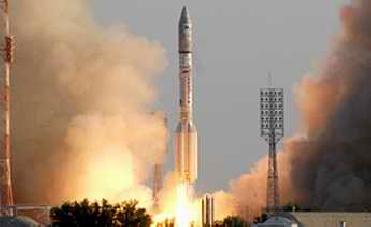
Chandrayaan was successfully launched on October 22. File photo
BANGALORE (BNS): India�s first unmanned spacecraft Chandrayaan-1 is slowly inching its way closer to the Moon.
On Tuesday evening at 6:30 local time, Indian Space Research Organisation (ISRO) scientists performed one more firing of the engine on board Chandrayaan-1 to reduce its periselene (nearest distance to the moon) from 187 km to 101 km. The firing of the engine lasted 31 seconds.
Speaking to the media, ISRO spokesperson S Satish said that the current orbit of Chandrayaan-1 is 255.3 km (the farthest distance from the moon) X 101.3 km (nearest distance to the moon). The orbital period is 2.09 hours.
�Further manoeuvres are planned in the coming days to bring the spacecraft to its final circular orbit of 100 km above the Moon's surface,� Satish said.
According to the spokesperson all sub-systems on board the spacecraft were working well.
The Spacecraft Control Centre (SCC) here will issue commands to the spacecraft�s engine, called the Liquid Apogee Motor (LAM), for reducing its aposelene from 255 km to 100 km on Wednesday evening. After the successful completion of this, the spacecraft will be in its final circular orbit of 100 km above the Moon, sources said.
It may be recalled that the first orbit reduction manoeuvre of Chandrayaan-1 spacecraft which is orbiting the Moon, was successfully performed on the night of November 9, 2008. As part of that manoeuvre which began at 20:03 IST, the 440 Newton liquid engine of the spacecraft was fired for about 57 seconds. With this, the nearest point of
Chandrayaan-1�s orbit (periselene) from the moon�s surface was reduced from 504 km to 200 km while the farthest point (aposelene) remained unchanged at 7,502 km. In this elliptical orbit, Chandrayaan-1 takes about ten and a half hours to circle the Moon once.
The spokesperson said that the health as well as the orbit of Chandrayaan-1 spacecraft was being closely monitored from the Spacecraft Control Centre of ISRO Telemetry, Tracking and Command Network in Bangalore with crucial support from Indian Deep Space Network antennas at Byalalu. The spacecraft performance is normal, he said.
 Next Article
Next Article













The Indian Air Force, in its flight trials evaluation report submitted before the Defence Ministry l..
view articleAn insight into the Medium Multi-Role Combat Aircraft competition...
view articleSky enthusiasts can now spot the International Space Station (ISS) commanded by Indian-American astr..
view article